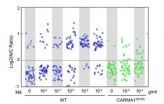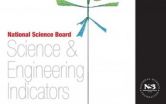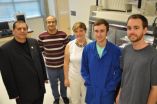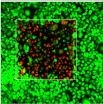(Press-News.org) The immune system's B cells protect us from disease by producing antibodies, or "smart bullets," that specifically target invaders such as pathogens and viruses while leaving harmless molecules alone. But how do B cells determine whether a threat is real and whether to start producing these weapons?
An international team of life scientists shows in the May 16 issue of the journal Science how and why these cells respond only to true threats.
"It is critical for B cells to respond either fully or not at all. Anything in between causes disease," said the study's senior author, Alexander Hoffmann, a professor of microbiology, immunology and molecular genetics in the UCLA College of Letters and Science. "If B cells respond wimpily when there is a real pathogen, you have immune deficiency, and if they respond inappropriately to something that is not a true pathogen, then you have autoimmune disease."
The antibodies produced by B cells attack antigens — molecules associated with pathogens, microbes and viruses. A sensor on the cell's surface is meant to recognize a specific antigen, and when the sensor encounters that antigen, it sends a signal that enables the body's army of B cells to respond rapidly. However, there may be similar molecules nearby that are harmless. The B cells should ignore their signals — something they fail to do in autoimmune diseases.
So how do the B cells decide whether to start producing antibodies?
"These immune cells are somewhat hard of hearing, which is appropriate because the powerful and potentially destructive immune responses should jump into action only when danger calls, not when it whispers," said Hoffmann.
The B cells make their response only when a rather high threshold is reached, Hoffmann and his colleagues report. A small or moderate signal — from a harmless molecule, for instance — gets no response, which reduces the risk of false alarms.
"It's like your car's airbag, which won't be deployed unless you really need it," Hoffmann said. "You can imagine that if the airbag were poorly designed and if you brake very hard or have a slight accident, it could deploy slowly and be useless. You want it to deploy fully or not at all. That is what the B cell does when deciding whether it confronts something that is truly pathogenic or harmless. No B cell responds partially."
We have billions of B cells, and each one creates this threshold through a molecular circuit involving two molecules. One of these molecules, known as CARMA1, activates the other, IKKb, which further activates the first one.
"Positive feedback between the two causes infinite growth, and once you trigger it, there is no way to turn it off until the smart bullets are shot," said Hoffmann, whose research aims to understand and decode the language of cells. "But a second feature of positive feedback is that it can create a threshold only above which this runaway activation occurs."
He and his colleagues developed mathematical equations based on the molecular circuit and were then able to simulate, virtually, B cell responses. The team's resulting predictions were tested experimentally by their collaborators at the Laboratory for Integrated Cellular Systems at Japan's RIKEN Center for Integrative Medical Sciences. In one part of the study, the researchers made specific mutations in IKKb so that it could not signal back to CARMA1. They also made mutations in CARMA1 to prevent it from receiving the signal from IKKb. In both cases, the B cells responded partially, some of the time, like a weakly inflating airbag.
"It became a gray-zone response rather than a black-and-white response," said Hoffmann, who constructs mathematical models of biology.
The research could lead to better diagnosis of disease if patients with an autoimmune disorder, such as lupus, have a defect in this molecular circuit.
INFORMATION:
Co-authors of the study included Mariko Okada-Hatakeyama, a professor at Japan's RIKEN Center, and Marcelo Behar, a postdoctoral scholar in Hoffmann's laboratory who has now accepted a position as an assistant professor at the University of Texas, Austin.
Funding sources for the research included federal grants to Hoffmann by the National Cancer Institute and National Institute of Allergy and Infectious Diseases (grants R01CA141722, R01AI083453), both part of the National Institutes of Health, and funding to Okada-Hatakeyama from the Cell Innovation Program of Japan's Ministry of Education, Culture, Sports, Science and Technology, and the Japan Society for the Promotion of Science.
Hoffmann's research: Correcting cellular miscommunication
Many diseases are related to miscommunication in cells, Hoffmann said. In other research, he and colleagues showed for the first time that it is possible to correct a certain type of cellular miscommunication — one involving the connection of receptors to genes controlled during inflammation — without severe side effects. That research, federally funded by the NIH, was published in the journal Cell on Oct. 10, 2013.
Hoffmann and his colleagues may be able to develop therapeutic strategies that do not simply inhibit or shut down faulty communication lines in diseased cells but actually correct the misunderstanding. (They have already accomplished this with cells in a Petri dish. Their next step is to see if this can be done in an animal, and then in a human.)
B cells produce antibodies 'when danger calls, but not when it whispers'
The specialized immune cells only act when specific threshold is reached
2014-05-15
ELSE PRESS RELEASES FROM THIS DATE:
Researchers show emissions from forests influence very first stage of cloud formation
2014-05-15
PITTSBURGH—Clouds play a critical role in Earth's climate. Clouds also are the largest source of uncertainty in present climate models, according to the latest report of the Intergovernmental Panel on Climate Change. Much of the uncertainty surrounding clouds' effect on climate stems from the complexity of cloud formation.
New research from scientists at the CLOUD (Cosmics Leaving OUtdoor Droplets) experiment at CERN, including Carnegie Mellon University's Neil Donahue, sheds light on new-particle formation — the very first step of cloud formation and a critical component ...
New data show how states are doing in science
2014-05-15
The newly updated, online, interactive state data tool allows policymakers, educators and other users to discern trends in education, science and research in each of the 50 states. This free resource supplements the state data in the 2014 Science and Engineering Indicators report, the premier source of information and analysis of the nation's position in science and engineering education and research. The biennial report is published by the National Science Board, the policy making body of the National Science Foundation (NSF).
The tool features 59 state indicators of ...
UH Case Medical Center neurosurgeon uses depth electrodes for speech mapping
2014-05-15
CLEVELAND -- At the 2014 American Association of Neurological Surgeons Annual Meeting, neurosurgical researchers from University Hospitals (UH) Case Medical Center presented results from a small study looking at deep brain electrode implantation as a possible alternative to the traditional WADA test used prior to epilepsy surgery.
The WADA test is considered the gold standard for identifying the side of the brain for speech dominance. In the WADA test, doctors put one half of a patient's brain to sleep for a few minutes using medication and then have the patient read ...
Study: Targeted funding can help address inequities in early child care programs
2014-05-15
CORVALLIS, Ore. – The quality of early child care and education programs is influenced both by funding and by the characteristics of the communities in which the programs operate, new research from Oregon State University shows.
The findings indicate that law- and policy-makers may need to consider the demographics of communities when making funding decisions about early childhood programs, said Bridget Hatfield, an assistant professor in OSU's College of Public Health and Human Sciences.
That's especially important now because many states, including Oregon, are adopting ...
Fires in San Diego County blazing
2014-05-15
The single fire that ignited and split into nine separate fires still blazes in Southern California today. Firefighters are hoping for a break today (Thursday, May 15, 2014) but it doesn't look like luck may be on their side. Conditions continue to be bone dry with unseasonal heat (98-106 degrees) and the Santa Ana winds are kicking up and allowing these fires to easy jump fire lines. This particular fire started on Wednesday as a single fire and within a day is now nine separate fires which have burned close to 10,000 acres. These fires are threatening more than just ...
Giant telescope tackles orbit and size of exoplanet
2014-05-15
Using one of the world's largest telescopes, a Lawrence Livermore team and international collaborators have tracked the orbit of a planet at least four times the size of Jupiter.
The scientists were able to identify the orbit of the exoplanet, Beta Pictoris b, which sits 63 light years from our solar system, by using the Gemini Planet Imager's (GPI) next-generation, high-contrast adaptive optics (AO) system. This approach is sometimes referred to as extreme AO.
The Gemini Planet Imager snapped an amazingly clear and bright image of the gas giant Beta Pictoris b after ...
Detailed studies reveal how key cancer-fighting protein is held in check
2014-05-15
St. Jude Children's Research Hospital scientists have mapped the structural details of how p53 attaches to its regulatory protein, called BCL-xL, in the cell. The protein p53 is a key activator of the cell's protective machinery against genetic damage, such as the mutations that drive cancer cells' explosive growth.
The detailed understanding of how these two molecular puzzle pieces fit together will help scientists design drugs that release p53 in cancer cells, triggering their suicide, called apoptosis.
The findings appear in the current online journal Nature Structural ...
Researchers examine intersection of aging, chronic disease
2014-05-15
A new collection of articles appearing in The Journals of Gerontology, Series A: Biological Sciences and Medical Sciences examine how the basic biology of aging drives chronic disease. Together, they highlight the value of the emerging field of geroscience, which uses an integrated approach to the study of diseases and disability associated with growing older.
Geroscience seeks to bridge the divide between studies of aging and studies of chronic disease, with the hope of understanding their complex relationship and pointing the way to novel interventions for disease, ...
Silly Putty material inspires better batteries
2014-05-15
RIVERSIDE, Calif. (http://www.ucr.edu) — Using a material found in Silly Putty and surgical tubing, a group of researchers at the University of California, Riverside Bourns College of Engineering have developed a new way to make lithium-ion batteries that will last three times longer between charges compared to the current industry standard.
The team created silicon dioxide (SiO2) nanotube anodes for lithium-ion batteries and found they had over three times as much energy storage capacity as the carbon-based anodes currently being used. This has significant implications ...
Going beyond the surface
2014-05-15
BUFFALO, N.Y. – Photodynamic therapy (PDT) is an effective treatment for easily accessible tumors such as oral and skin cancer.
But the procedure, which uses lasers to activate special drugs called photosensitizing agents, isn't adept at fighting cancer deep inside the body. Thankfully, that's changing due to new technology that could bring PDT into areas of the body which were previously inaccessible.
Described May 11 in the journal Nature Photonics, the approach involves using near-infrared beams of light that, upon penetrating deep into the body, are converted into ...
LAST 30 PRESS RELEASES:
Air pollution exposure and birth weight
Obstructive sleep apnea risk and mental health conditions among older adults
How talking slows eye movements behind the wheel
The Ceramic Society of Japan’s Oxoate Ceramics Research Association launches new international book project
Heart-brain connection: international study reveals the role of the vagus nerve in keeping the heart young
Researchers identify Rb1 as a predictive biomarker for a new therapeutic strategy in some breast cancers
Survey reveals ethical gaps slowing AI adoption in pediatric surgery
Stimulant ADHD medications work differently than thought
AI overestimates how smart people are, according to HSE economists
HSE researchers create genome-wide map of quadruplexes
Scientists boost cell "powerhouses" to burn more calories
Automatic label checking: The missing step in making reliable medical AI
Low daily alcohol intake linked to 50% heightened mouth cancer risk in India
American Meteorological Society announces Rick Spinrad as 2026 President-Elect
Biomass-based carbon capture spotlighted in newly released global climate webinar recording
Illuminating invisible nano pollutants: advanced bioimaging tracks the full journey of emerging nanoscale contaminants in living systems
How does age affect recovery from spinal cord injury?
Novel AI tool offers prognosis for patients with head and neck cancer
Fathers’ microplastic exposure tied to their children’s metabolic problems
Research validates laboratory model for studying high-grade serous ovarian cancer
SIR 2026 delivers transformative breakthroughs in minimally invasive medicine to improve patient care
Stem Cell Reports most downloaded papers of 2025 highlight the breadth and impact of stem cell research
Oxford-led study estimates NHS spends around 3% of its primary and secondary care budget on the health impacts of heat and cold in England
A researcher’s long quest leads to a smart composite breakthrough
Urban wild bees act as “microbial sensors” of city health.
New study finds where you live affects recovery after a hip fracture
Forecasting the impact of fully automated vehicle adoption on US road traffic injuries
Alcohol-related hospitalizations from 2016 to 2022
Semaglutide and hospitalizations in patients with obesity and established cardiovascular disease
Researchers ‘listen in’ to embryo-mother interactions during implantation using a culture system replicating the womb lining
[Press-News.org] B cells produce antibodies 'when danger calls, but not when it whispers'The specialized immune cells only act when specific threshold is reached





